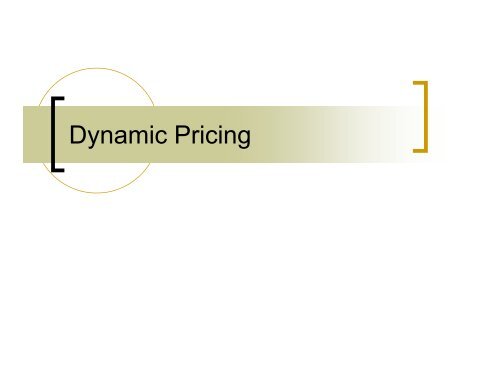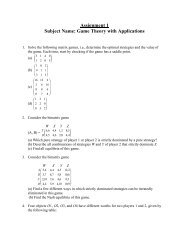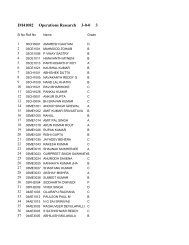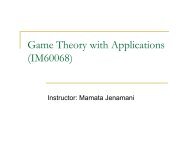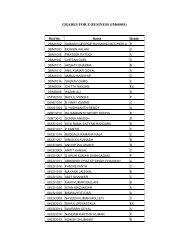Dynamic Pricing and Auction - Department of Industrial Engineering ...
Dynamic Pricing and Auction - Department of Industrial Engineering ...
Dynamic Pricing and Auction - Department of Industrial Engineering ...
You also want an ePaper? Increase the reach of your titles
YUMPU automatically turns print PDFs into web optimized ePapers that Google loves.
Underst<strong>and</strong>ing the scope fordynamic pricingD1D2Srice PrP2P1Quantity
Some important observations• It appears that prices should change dynamicallydepending on the market condition◦ In fact dynamic pricing has a history which is as old as thehuman civilization◦ Fixed pricing has a history which is only 100 years old.• <strong>Dynamic</strong> pricing ensures perfect competition◦ No consumer or the producer is large enough to controlthe market.◦ Efficient allocation <strong>of</strong> resources◦ The economy is at its production possibility frontier• If dynamic pricing is so natural why did people g<strong>of</strong>or fixed pricing?
Advantages <strong>of</strong> ffixed pricing• Convenient◦ Easy to model◦ Designed to recover the cost <strong>of</strong> production(break-even)◦ Difficulty in estimating dem<strong>and</strong>• Decrease price uncertainty in the market◦ Loyal customers• An instrument to control the market• …
Some insights into traditional(Fixed) pricing methods
A six step procedure forsetting up price• Selecting the pricing objective• Determining the dem<strong>and</strong>• Estimating the cost• Analyzing competition• Selecting a pricing method• Selecting the final price
Selecting the pricing objectives• Maximizing the current pr<strong>of</strong>it◦ Estimate t dem<strong>and</strong> d <strong>and</strong> cost associated with alternativetiprices <strong>and</strong> choose the one that produces maximum pr<strong>of</strong>it/cash flow/ rate <strong>of</strong> return on investment• Estimating the dem<strong>and</strong> !!,• Govt. restrictions !!• Competitor’s reaction !!• Market penetration strategy◦ Maximizing i i the market share◦ Price sensitive market◦ Higher sales volume leads to lower cost• Market skimming◦ High prices to skim the market before the substitutearrives• Product-quality-leadershipleadership◦ Higher prices based on higher quality
Determining dem<strong>and</strong>• Estimating dem<strong>and</strong> curve• Price sensitivity <strong>of</strong> the customers• Price elasticity <strong>of</strong> dem<strong>and</strong>• Dem<strong>and</strong> sets the ceiling <strong>of</strong> the price
Estimating cost• Costs sets floor <strong>of</strong> the price• Fixed cost• Variable cost
Analyzing competition• Competitor’s cost, price <strong>and</strong> <strong>of</strong>fers• Stay as close as possible
Selecting a pricing method• Markup pricing◦ Unit price = unit cost / (1 – markup on sales)• Target return pricing◦ Unit cost + [(desired return*invested capital)/unit sales]• Perceived value pricing◦ Service, warranty, reliability etc.• Value pricing◦ Quality Vs. Price• Going rate pricing◦ Competitor’s price• Sealed-bid pricing/ <strong>Auction</strong>s
Was the traditional pricingreally fixed?• Volume discounts?• Bargaining <strong>and</strong> Negotiations?• Product mix pricing?• Promotional pricing?i • …
E-Commerce as a driver <strong>of</strong>dynamic pricingi• What buyers can do◦ Gets instant price comparisons◦ Instant search for the substitutes that fits the budget• What sellers can do◦ Monitor customer behavior <strong>and</strong> instant tailoring <strong>of</strong>customized price◦ Change price on the fly after sensing dem<strong>and</strong>d• Both can do◦ Instant negotiation on price• <strong>Auction</strong>s• Exchanges• Internet has created a conducive environment forperfect competition hence dynamic pricing isbecoming a reality
E-Commerce as a driver <strong>of</strong>dynamic pricing• Transaction cost for implementing the dynamicpricing i have been reduced d by◦ Eliminating the need for people to be physicallypresent in time <strong>and</strong> space◦ Reducing the search cost◦ Reducing the menu cost <strong>of</strong> informing the changedprice• Increased number <strong>of</strong> customers, competitors,<strong>and</strong> increased amount <strong>of</strong> information has leadto price uncertainty <strong>and</strong> dem<strong>and</strong> volatility.• Companies are finding that using a single fixedprice in these volatile market is inefficient <strong>and</strong>ineffective
Defining <strong>Dynamic</strong> <strong>Pricing</strong>• <strong>Dynamic</strong> pricing is defined as the buying<strong>and</strong> selling <strong>of</strong> goods <strong>and</strong> services in freemarkets where the prices fluctuate inresponse to changing supply <strong>and</strong> dem<strong>and</strong>.• Also called flexible pricing/ customizedpricing• Includes two aspects◦ Price dispersion◦ price differentiation
Price dispersion• Spatial◦ Several seller <strong>of</strong>fers a given item indifferent prices• Temporal◦ A seller varies the price <strong>of</strong> a given itemover the time◦ Ex: Seasonal discounts
Price DifferentiationBased on one product• First degree differentiation◦ Perfect differentiation◦ Same product, different price for different people◦ Extracts maximum consumer surplus from the market◦ Ex: <strong>Auction</strong>• Second degree differentiation◦ Non-linear pricing◦ Different quantity for different unit price but the rule is same for eachindividual◦ Ex: Volume discounts, Utility prices• Third degree differentiation◦ Group pricing◦ Same unit price for any quantity but unit price is different for differentgroups <strong>of</strong> people◦ Ex. Telecom pricing for business <strong>and</strong> households
Price DifferentiationBased on one product which can be customized• Addition or deletion <strong>of</strong> attributes• Decreased substitutability• Customized product• Ex.: Dell – Computers with customizedfeatures• Ex: Airline industry – Productdifferentiation based on refund policy
<strong>Dynamic</strong> pricing successstories• Airline Industry◦ Yield management• Priceline.com◦ Negotiation with major airlines to fill upthe vacant seat with the marginalrevenue• Online auctions• …
<strong>Dynamic</strong> pricing failure stories• DVDs from Amazon.com◦ Lost customer loyalty• Buy.com◦ Price competion◦ Pr<strong>of</strong>it is low or even sometimes negative
Conditions under which dynamicpricing will be successful• Customer must be heterogeneous in theirwillingness to pay• Market must be segmentable• Reselling at a higher price should be prohibited• The cost <strong>of</strong> segmenting <strong>and</strong> price differentiationmust not exceed the revenue due to pricecustomization• Customer should feel fairness in dynamic pricing• <strong>Dynamic</strong> pricing must be based on sophisticatedmathematical models.
Models for dynamic pricing• Inventory based model◦ Models based on inventory type, inventory levels <strong>and</strong>customer service levels• Data driven models◦ Models based on statistical techniques that uses the dataavailable on customer preferences <strong>and</strong> buying patterns• <strong>Auction</strong>s◦ Models where prices vary based on the market condition• Machine learning models◦ Models based on online learning• Simulation models
<strong>Auction</strong>
<strong>Auction</strong>• An oldest form <strong>of</strong> market◦ A history <strong>of</strong> at least 500 BC◦ From Babylonian auction to eBay• Theoretical studies started in 1970 with◦ Organization <strong>of</strong> Petroleum Exporting Countries (OPEC)increased the price◦ US Dept <strong>of</strong> Interior decided to action the drilling rights in thecostal area◦ Economists were hired by the organizations to design biddingstrategies• Federal communication commission (FCC)◦ Radio spectrum auction◦ Resulted a revenue <strong>of</strong> 23 billion US$• New Zeal<strong>and</strong> Spectrum auction◦ Vickrey <strong>Auction</strong>◦ Winning bid NZ$100, 000 – second highest bid NZ$ 6 !!
A framework for classifying theauctions• Resources• Market structure• Preference structure• Bid structure• Bidding rule• Matching supply to dem<strong>and</strong>• Information feedback• Nature <strong>of</strong> the goodhttp://www.eecs.harvard.edu/econcs/pubs/eh<strong>and</strong>book.pdf
Classification based on the resources• Identify the set <strong>of</strong> resources over which the negotiation is tobe conducted• Single item single unit• Single item multiple l unit◦ Multi-unit auction• Multiple Items◦ Combinatorial auction◦ Homogeneous items or heterogeneous items◦ Sequential or simultaneous• Items with multiple attributes◦ <strong>Pricing</strong> out mechanism for non-priced attributes throughsome utility function◦ Multi attribute auction
Classification based on MarketStructure• An auction is a mechanism for negotiationbetween buyers <strong>and</strong> seller• One seller – multiple buyer◦ Forward auction• One buyer – multiple seller◦ Reverse auction• Multiple buyers – multiple sellers◦ Double auction◦ Trading securities <strong>and</strong> financial instruments
Classification based on Bidding rules• Ascending bid auction◦ English auction◦ Reserve price◦ Bid Increment• Descending bid auction◦ Dutch auction• Sealed-bid auction◦ First-price◦ Second-price (Vickrey auction)
Classification based on Preferencestructure• Preference defines an agent’s utility for differentoutcomes• In case <strong>of</strong> multi unit auctions◦ Agent may show a decrease in marginal utility foradditional units <strong>of</strong> the product• In case <strong>of</strong> multi-attribute auction◦ Agent ‘s preference structure for different attributes is tobe designed d in terms <strong>of</strong> scoring rules used to signalinformation
Classification based on Bid structure• Structure <strong>of</strong> a bid defines the flexibility with whichan agent can express his resource requirement• Ex: In single-itemitem single-unit auction it is simplythe buyer’s willing ness to pay or accept.• Ex: In single-item multi-unit case the buyer needsto specify both quantity <strong>and</strong> price• Ex: In case <strong>of</strong> multi-item case a bid may bespecified as all-or-nothing over a basket <strong>of</strong> items.
Classification based on Payment rule• First price• Second price• All pay
Classification based on Matchingsupply with dem<strong>and</strong>• Market clearing or winner determinationtiproblem• Single sourcing◦ A sorting problem• Multiple l sourcing◦ A combinatorial problem• The problems range from simple sortingproblems to NP-Hard Optimizationproblems
Classification based on Informationfeedback• <strong>Auction</strong> protocol based on direct or indirectmechanism• Direct mechanism◦ No feedback• Price signal◦ Ex. First-price sealed bid auction• Indirect Mechanism◦ Feedback on the state <strong>of</strong> the auction• Price signal• Provisional allocation◦ English auction
Issues involved in onlineauction• Strategic Issues◦ Economic Issues (<strong>Auction</strong> design issues)◦ Business Issues (Business rules)◦ ..• Implementation Issues◦ Modeling the decision making process◦ Computational Issues◦ Security
Economic Considerations
<strong>Auction</strong> Design Problem• Design auction that have somedesirable property p to satisfy theauctioneers need◦ Modeling preference, behavior <strong>and</strong>information available to the agents◦ Designing g mechanisms in which theagent strategies result in the outcomeswith the desirable properties.
Two approaches for auctiondesign• Game theoretic/mechanism ti h i design approach◦ In this model the equilibrium state is defined by thecondition that the agent plays the best responsestrategy to each other <strong>and</strong> cannot benefit fromunilateral deviation to an alternate strategy◦ Rationality assumption• Price taking or competitive equilibrium approach◦ In this model the equilibrium state is defined by thecondition that an agent plays a best response to thecurrent price <strong>and</strong> allocation in the market, withoutmodeling the strategies <strong>of</strong> the other agents or the effect<strong>of</strong> its own action on the future state <strong>of</strong> the market◦ Myopic, best response
Game theoretic/mechanismdesign approach
Modeling bidders valuation <strong>of</strong> aproduct• Private value model◦ Each participant has a potentially different value for good inthe question◦ Symmetric (or asymmetric)• All the bidders draw their values from a common distribution• Common value model◦ The good in the question has the same value for all theparticipants• Interdependent Value Models◦ Each bidder has only an estimate regarding the value.◦ This estimate t may change after getting the price signal fromothers.
<strong>Auction</strong> mechanism designgoals• Pareto efficiency◦ Design an auction that results in a Pareto efficientoutcome◦ The item under consideration goes to the person whoneeds it most (He may not pay the highest amount)◦ After trade should not be possible• Pr<strong>of</strong>it maximization◦ Design an auction that yields the highest expectedpr<strong>of</strong>it to the seller◦ The item should go to the person who pays the highestamount.
Efficiency Vs. optimality• Optimal auctions are designed to maximize the expected revenue <strong>of</strong> theseller by using a set <strong>of</strong> tools including posing a reserve price or chargingan entry fee, whereas the objective <strong>of</strong> efficient auctions is to maximizethe social welfare, the sum <strong>of</strong> the players' surplus.• Efficient i design aims to maximize i the system welfare, whereas theoptimal design aims to maximize the seller's individual revenue.• Since optimality <strong>and</strong> efficiency usually cannot be achievedsimultaneously, the auction designers have to make the choice before hestates the rules <strong>of</strong> the auction.• A financial self-interested agent may prefer the optimal auctions while a• A financial self-interested agent may prefer the optimal auctions, while apublic agent like the government may prefer the efficient auctions to gainmore social welfare. Nevertheless, all agents need to balance optimality<strong>and</strong> efficiency to make the auctions practical.
The concept <strong>of</strong> efficiency <strong>and</strong> pr<strong>of</strong>itmaximization i <strong>and</strong> three popular mechanisms• Efficiency◦ All the major action formats are efficientassuming the bidder is truthful• Optimality◦ First price auction <strong>and</strong> English auctionsare optimal.◦ What about the second price auction?◦ It becomes optimal if an appropriatereserve price is set.
Modeling the basic auction mechanisms• <strong>Auction</strong> is a Bayesian game◦ Bidders are the players◦ The problem is either to find a Bayes-Nash equilibrium point forefficient allocation or to propos a mechanism based on revelationprinciplep◦ Incentive-compatible direct mechanisms yield the same Bayes-Nashequilibrium point as the original problem• The formulation help finding the efficient allocation• Assumptions <strong>of</strong> the basic model◦ n bidders◦ Bidder’s values are independent <strong>and</strong> identical r<strong>and</strong>om variables withdistribution function F(V) <strong>and</strong> density function f(V)(symmetric, independent bidders)◦ Bidders are risk neutrality◦ They show no collusion or predatory behavior• Under this assumption all the basic auction formats are efficient<strong>and</strong> generate same revenue
Bidding Strategy in second priceauction• In a second price under IPV setting <strong>and</strong> with riskneutral bidders bidding truthfully is a dominantstrategy• The item under consideration goes to the bidderwho values it most.• The value is measured in terms <strong>of</strong> price. So theitem must go to the bidder with highest valuationfor the product.• Considering the bid as a proxy for the valuation,the item may go to the highest bidder. But, whatis the guarantee that the all the bidders bidtruthfully?
Bidding Strategy in second priceauction• A case <strong>of</strong> two bidders◦ Let the valuations are v 1 , <strong>and</strong> v 2◦ Let the bids are b 1 <strong>and</strong> b 2◦ Expected pay<strong>of</strong>f <strong>of</strong> 1 st bidder isprob[b 1 ≥ b 2 ][v 1 -b 2 ]If v 1 >b 2 then in order to win the bidder 1 will make b 1 ashigh as possible. This happens when he sets b 1 =v 1If v 1
Revenue in second priceauctionn bidders independently draw their valuations from distribution function F(.) <strong>and</strong> density function f (.)Bidders' values: { v1, v2, ... , v n} (under IID assumption,i.e., i each is a independent <strong>and</strong> identicallydistributed r<strong>and</strong>om variable)Order statistics: { v(1) , v(2) , ... , v( n )} (arranged in ascending order)thn!Density <strong>of</strong> k lowest: f( v( k ))=f v F v F v( k −1)!( n−k)!k−1n−k().[ ()] .[1 − ()]Uniform distribution case, i.e., for U[0,1]th n!k−1Density <strong>of</strong> k lowest: f( v( k )) = . v .[1 −v]( k−1)!( n−k)!(This is a β distribution with paremeters k <strong>and</strong> ( n- k+ 1)thkMean value <strong>of</strong> k order statistic: E( v( k ))=( n + 1)nd( n −1)Mean value <strong>of</strong> 2 order statistic: E( v(2)) =( n +1)(expected revenue for the auctioneer)n−k
Density <strong>of</strong> the k th lowest order statisticthDensity <strong>of</strong> k lowest:Pr{ x< x ≤ x+dx}( k )=Pr{[ P{[ x < one <strong>of</strong> the X ' s ≤ x+ dx ] ∩[ X ≤ x for ( k −1) X ' s]At limit when dx → 0 :i i i∩[ X > x for the remaining ( n−k) X ' s]}[ F( x+ dx) −F( x)]f v ) = c c [ F( x)] .[1 −F( x)]dxn!k−1n−kf ( v( )) = kf ( x)[ ).[ F ( x)] .[1 F ( x)]( k−1)!( n−k)!−n n−1 k−1n−k(( k ) 1 k −1ii
Bidding Strategy in 1 stprice auctionE[Gain]=( v - b) Pr( winning)Optimal bid is the one that maximizes this expectationfor bidders with distribution function F(.) <strong>and</strong> density function f(.)( n −1)Optimal bid = b* =vnTo see the result, we have to develop the bidding strategy for the bidders
Eq. 1Eq. 1(Eq. 1)Eq. 2
Eq. 3Eq. 4
Eq. 4Eq. 5Eq. 6
tRevenue in 1 st price auction• The winning (highest) bid is the bid <strong>of</strong>the person with the highest orderstatistic:stMean value <strong>of</strong> 1 order statistic: E( v ) =(1)n( n +1)( n−1) ( n−1) n ( n−1)Expected Payment = E( v()(1)) = =n n ( n+ 1) ( n+1)
Revenue EquivalenceTheorem• Under IPV setting with risk neutralbidders, the expected price paid for theobject is same under first price auction<strong>and</strong> the second price auction.
Strategic equivalence <strong>of</strong> the auctions• A first price auction is strategicallyequivalent to Dutch auction for riskneutral bidders under IPV setting• A second price auction is strategicallyequivalent to English auction for riskneutral bidders under IPV setting• Therefore the revenue generated fromall the common auction formats are thesame
Optimal Mechanisms• Increasing the expected revenue• Two ways◦ Increasing the number <strong>of</strong> bidders◦ Setting up a reserve price
More Bidders=higher Expected Pay<strong>of</strong>fFor n bidders with IPV <strong>and</strong> V~U(50,100):
Reserve Prices• A minimum price, r, below which theseller does not sell the item◦ “Excludes” some bidders with v < r• Proper reserve price increasesrevenue
Why set a reserve price?• Consider two bidders in a 2nd price auction): (auctioneer’s value = 0,reservation price = r) )◦ If both the bids are above r• E[Gain]=No change◦ If both the bids are below r• E[Loss] ≤ r[F(r)] 2◦ r: loss, P[x
Calculating the optimal reserve priceGiven r, assume the seller raises it to r+ δ.(Assume value to seller is 0)Good move: if there is exactly a single bidder bidding above (r+ δ )].n-1Pr · ( ) .[1- ( δ )]= nF r F r+Gain = δBad move: if the highest bid is between r <strong>and</strong> (r+ δ ).n-1Pr = n· F () r ·[ F ( r +δ) - F ()] rLoss = r
Calculating the optimal reserve priceNet expected gain per increment in r *n-1 n-1nFr · () .[1- Fr ( + δ)]. δ nFr · () .[ Fr ( + δ)- Fr ()]. r∆ ( δ ) =δ−Taking the limit:n-1∆ ( δ) = nF · () r .{[1- F ()] r −f (). r r}lim δ →0Setting ∆=0:[1- Fr(*)]r*=f(*)rδ
Relaxing the basic assumptions◦ Risk aversion• Worried about not winning• Bids higherh• Prefers English auction◦ Asymmetric valuations• Strong Vs. Weak bidder◦ Reputation ti effect• Aggressive
Interdependencies• Interdependent values -a bidder’s valuation isaffected by knowing the valuation <strong>of</strong> other bidders◦ Each bidder has only a partial information about thevalue <strong>of</strong> the item being sold in the form <strong>of</strong> a signal,which is a r<strong>and</strong>om variable• Pure common value – item has the same valuefor all bidders. Each bidder has only an(unbiased) estimate/signal <strong>of</strong> the value prior tothe auction
Revenue Calculation• English auction <strong>and</strong> second price auctions are nolonger equivalent• English auctions are likely to yield more revenuethan both 1 st <strong>and</strong> 2 nd price auctions.• More information flow is likely to increase thevalue <strong>of</strong> the object. Therefore, releasing all theinformation about the item being sold theauctioneer may yield more pr<strong>of</strong>it.
Winner’s Curse• The winner curse takes place when winner paystoo much, due to their failure to anticipate <strong>and</strong>correct their bidding strategy• The winner is the bidder with highest signal.• Winning means that everybody else had a lowerestimate• To correct winner’s curse bidders have to “shave”their bids further (1st price “shave” +WC “shave”)
The Winner DeterminationProblem <strong>and</strong> its Complexity
A simple winner determination problemWhat kind <strong>of</strong> auction?◦ single-item◦ single-unit max∑vxiii◦ single winnerst . ∑ xi≤1◦ forward auctionixi∈{0,1}◦ price only bidsWhere viis the price <strong>of</strong> item i,xiis a binary variable indicatingpurchasing decision on item iHowdowesolveit?we ◦ A simple sortingproblem !!
Winner determination problem incomplex auction formats• Multi unit auctions• Multi Attribute auctions◦ Forward auction◦ Reverse <strong>Auction</strong>◦ Constraint types• Divisible bid• Indivisible bid• Price Schedule• Multi-item auctions◦ Forward auction◦ Reverse <strong>Auction</strong>◦ Constraints types• Number <strong>of</strong> winningsuppliers• Budget limit on trades• Market share constraints• Representationconstraints• Volume discounts◦ Reverse auction◦ Constraint types• Single sourcing• Multiple pe sourcing• Double auctions <strong>and</strong>exchanges◦ Trading securities <strong>and</strong>financial instruments◦ Continuous double auction• Clears continuously◦ Clearinghouse auction• Periodic clearing◦ Constraint types• Aggregation• Divisibility• Homogeneous /heterogeneous items
Multi unit auctions• Forward auction◦ Maximization <strong>of</strong> selling price• Reverse <strong>Auction</strong>◦ Minimization <strong>of</strong> procurement cost• Bid types◦ Divisible i iblbid◦ Indivisible bid◦ Price Schedule
Multiunit auction with divisible bidsBidder (i) Bid (p i , q i ) max ∑ px i i1(20, 30) 3 Total quantity soldist .∑ xi≤ Q2i(30, 30) 1 Total quantity soldxi≤qix ≥ 0∀i34 (10, 30)5(25, 20) 2Total Quantity to Sell =100Total Quantity Sold =100(15, 60) 4 (Only 20 units are sold)Total Revenue=30*30+25*20+20*30+15*20Total quantity soldiWhereiThe buyer ipiis unit priceqiis the quantityQ is the total dem<strong>and</strong>,x i is the decision variable• Each bid is represented as a pricequantity ty pair (p i, q i )• Again a simple sorting problem• Last chosen bid gets partial allocation!!
Multiunit auction with indivisible bidsBidder (i) Bid (p max pqxi ,q i )∑i i i1 (20, 30)(30, 30)123 st .∑xiiqxiii≤ Q∈{0,1}∀i3(15, 60)4 (10, 30)5(25, 20) 2Total Quantity to Sell =100Total Quantity Sold =80Total Revenue=30*30+25*20+20*30Wherei The buyer ipiis unit priceqiis the quantityQ is the total dem<strong>and</strong>,x i is the decision variablei• Each bid is represented as a price quantity pair(p i, q i )• A knapsack problem!!• What is the complexity if solved by Branch <strong>and</strong>Bound Algorithm?• A greedy algorithm does exist
Multiunit auction with price schedulefor volume discount bids• Price schedule for i th seller is represented asis the per unit price for the quantities in the intervalx 211 1Mx N i11min ∑∑ pzij ij+ pqxij ij ijx i= 1 j=1st .zij−( qij− q ) xij
Multi –item forward auctionsSet <strong>of</strong> items to be sold = {A, B, C, D, E}Two bidders submit the bundled bidsBundles <strong>of</strong> Bidder 1 Bundles <strong>of</strong> Bidder 2[100, {A,C,D}] [50, {E}][150, {A,B,C}][200, {C, E}]Only one bundlefrom each buyerEach item j isconsidered onlyonce[50, {A,B}][75, {B,C}][75, {D, E}]set <strong>of</strong> items to be soldthebidsetfrombidderibidder ip i (S) Price <strong>of</strong>fered by bidder i for bundle S
Multi –item forward auctions-A set packing problem• Given: A set <strong>of</strong> subsets S = S_1, ...,S m <strong>of</strong> the universal set U_• Problem: What is the largest number<strong>of</strong> mutually disjoint subsets from S?
Adding Business rules as side Constraintsfurther increases the complexity• Number <strong>of</strong> Winning Suppliers◦ Multi sourcing• Budget Limits on Trades◦ How much I can spend• Marketshare Constraints◦ How much business to allocate to each winner• Reservation Prices◦ What is the minimum price below which the seller willnot sell the product , i.e. minimum bid price
Double <strong>Auction</strong>s• A multiple buyer <strong>and</strong> multiple seller auction• Used in financial institutions for over a hundredyears◦ Ex. New York stock exchange• Two types◦ Continuous double auction, which clears continuously◦ Clearinghouse or call auction, which clears periodically
Determining the equilibrium point indouble auction(Supply)Sellers’Asks(Dem<strong>and</strong>)Buyers’Bids11Equilibrium69425 83 10Price109876543211 2 3 4SupplyDem<strong>and</strong>Quantity
Winner determination problem indouble auction• The problem is to maximize market surplus. Wheresurplus is defined as the difference between the bids<strong>and</strong> asks• In the last example where 4 sellers try to sell a singleunit <strong>of</strong> some homogeneous good, <strong>and</strong> 4 buyers bid tobuy a single unit each, the winner determination problemcan be formulated asmaxs.t4∑j=1x ijxij44∑∑i= 1 j=1≤ 1 ∀i( pj− pi) x∈{ 0,1} ∀i,jij
Other Considerations During Doubleauction problem formulation• Aggregation◦ Role <strong>of</strong> market maker in disassembling <strong>and</strong>reassembling bundles <strong>of</strong> items◦ Consideration <strong>of</strong> either buy side items or sell side itemsor both• Divisibility◦ Ability to satisfy a fraction <strong>of</strong> agent’s bids <strong>and</strong> asks• Homogeneous/Heterogeneous goods
Classification <strong>of</strong> Online <strong>Auction</strong> TypesONEBUYERSMANYBilateralWeb-based salesSELLE ERSONEMANYnegotiationsWeb-based procurement(Reverse) auctionsauctionsC2C <strong>and</strong> B2CWeb-basedexchangesC2B <strong>and</strong> B2B
Online design issues• Choice <strong>of</strong> appropriate mechanism◦ Currently the English auction is the dominant mechanismon the Internet.◦ Second price which is not well adopted in traditionalauctions has become an important option.• Bid constraint◦ Minimum bid• Reserve price◦ Maximum bid• Buy-now price• <strong>Auction</strong> Duration◦ Ending rules• Multi-unit auctions <strong>and</strong> h<strong>and</strong>ling complex auctionformats◦ Quick response time◦ Appropriate algorithms
Integrating Online <strong>Auction</strong>s into aFirm’s Business Model• B2C surplus auctions◦ A firm may use auctions to dispose <strong>of</strong>surplus inventory• B2C <strong>Auction</strong>s as a Regular SalesChannel• B2B surplus auctions• B2B procurement auctions• Use <strong>of</strong> auction intermediaries
Fraud in online auctions• <strong>Auction</strong> frauds constitute the largest part <strong>of</strong> all Internet frauds(60 %)(Internet Fraud Complaint Center (IFCC))• IFCC classifies auction frauds into six categories◦ Non-delivery <strong>of</strong> goods◦ misrepresentation <strong>of</strong> the items◦ Triangulation• The perpetrator buys items from an online merchant using stolencredit card number <strong>and</strong> then sells them to unsuspecting buyers.◦ Fee staking• Fee stacking occurs when a seller keeps adding hidden charges◦ Selling <strong>of</strong> black-market goods• Illegally copied s<strong>of</strong>tware packages, audio CDs, movie CDs <strong>and</strong>games• Improper packaging <strong>and</strong> does not <strong>of</strong>fer any form <strong>of</strong> warrantee orinstruction manual that may have come along with the originalgoods.◦ Multiple bidding <strong>and</strong> Shill bidding (Cheating)
Cheating• Cheating unlike other fraud categoriesleaves no direct evidence <strong>of</strong> itsoccurrence• Some <strong>of</strong> the reasons that encouragecheating over the Internet◦ Cheap pseudonyms◦ Greater information asymmetry◦ Lack <strong>of</strong> personal contact◦ The tolerance <strong>of</strong> bidders
Types <strong>of</strong> fCheatingCheating in<strong>Auction</strong>Induced bybidderInduced by auctioneerMultiple biddingBid shadingRingsShill biddingFalse bidsCheating in electronic auction
<strong>Auction</strong> at e-Bay-Models• All eBay auctions use a ascending-bid formatwhich is a hybrid <strong>of</strong> English <strong>and</strong> Second priceauction. with the important distinction that thereis a fixed end time set by the seller.Models:• St<strong>and</strong>ard <strong>Auction</strong>• Reserve Price <strong>Auction</strong>• Buy It Now Price• Dutch <strong>Auction</strong>◦ Distorted version <strong>of</strong> Dutch auction◦ Multi-unit unit auction with volume discount
The Proxy Bidding <strong>and</strong> BidIncrement• The proxy mechanism allows a bidder to submit a maximum bid (i.e.,maximum willingness to pay) with a guarantee that eBay will raise thebidder’s active <strong>of</strong>fer automatically until the bidder’s maximum bid value isreached.• The bid placed by the proxy system is referred as the bidder’s proxy bid.• In a reserve price auction, the seller’s reserve price is treated like anyother bid; if the buyer’s <strong>of</strong>fer meets or exceeds the reserve (secret) bidset by the seller, the buyer’s bid would be raised to that priceimmediately.• EBay enforces a minimum bid increment that, along with the current askprice, determines a lower bound on bids the server will accept.• The bid increment table specified by eBay defines a schedule in whichthe increments increases as the current ask price increases.<strong>Auction</strong> at e-Bay
Data available to a bidder• Item description• Number <strong>of</strong> bids• ID <strong>of</strong> all the bidders• Time <strong>of</strong> their bid <strong>and</strong> the bid amount◦ Except that <strong>of</strong> the highest bidder• Time remaining until the end <strong>of</strong> the auction,• Whether or not the reserve price has been met,• The current ask price (list price).◦ The list price is the second highest price plus a smallincrement as specified in the bid increment table <strong>of</strong> eBay.<strong>Auction</strong> at e-Bay
Bidding Strategies• Single bid engagement◦ Evaluator◦ Late bidder◦ Sniper• Multiple bid engagement.◦ Skeptic◦ Unmasking<strong>Auction</strong> at e-Bay
References• Everything you wanted to know about double auctionhttp://www.sci.brooklyn.cuny.edu/~parsons/projects/mech-design/publications/cda.pdf• <strong>Auction</strong>, bidding <strong>and</strong> exchange design, Jayant Kalagnanam, Davis Parkeshttp://www.eecs.harvard.edu/econcs/pubs/eh<strong>and</strong>book.pdf• Optimality <strong>and</strong> Efficiency in <strong>Auction</strong>s Design: A Survey Roger L. Zhan1 <strong>and</strong> Zuo-Jun Max Shen2plaza.ufl.edu/zhan/paper/zhanShenV2.pdfpdf• <strong>Auction</strong> Theoryhttp://ocw.mit.edu/NR/rdonlyres/<strong>Engineering</strong>-Systems-Division/ESD-260JFall2003/2CECCCEB-0165-42A3-B86A-B4BBA5A6930B/0/l18ch22auctheory.pdf• <strong>Auction</strong> Theory <strong>and</strong> practices◦ http://www.nuff.ox.ac.uk/users/klemperer/VirtualBook/VirtualBookCoverSheet.asp• Insight <strong>and</strong> analysis <strong>of</strong> online auctions http://delivery.acm.org/10.1145/390000/384160/p42-bapna.pdf?key1=384160&key2=1358585711&coll=GUIDE&dl=GUIDE,ACM&CFID=15885574&CFTOKEN=47438457• Managing Online <strong>Auction</strong>s: Current Business <strong>and</strong> Research Issueshttp://mansci.journal.informs.org/cgi/reprint/49/11/1457?maxtoshow=&HITS=10&hits=10&RESULTFORMAT=&fulltext=Managing+Online+<strong>Auction</strong>s%3A+Current+Business+<strong>and</strong>+Research+Issues+&searchid=1&FIRSTINDEX=0&sortspec=relevance&resourcetype=HWCIT


